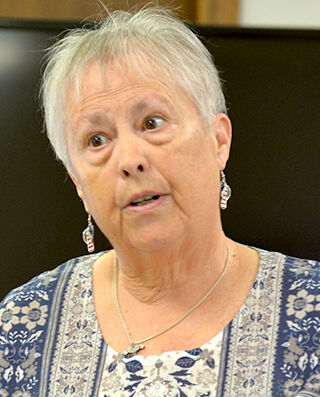Delve into your past by finding your roots

- By Stan Schwartz, Pike County News, Updated

Audrey Jones and Donna Carver visited the Bowling Green Rotary Club last week to highlight the work they’ve been doing on helping people learn more about their families through genealogy.
She brought with her invitations to the genealogical library and Jail Museum, along with a “get-out-of-jail-free card.”
Their Genealogical Society is housed in the same building where Pike County’s old jail was located. The jail is still there, but the cells have been turned into exhibits—each one with a different theme.
“We take you to jail, but we do let you back out,” Jones said, who has been a genealogist since 1975. She got started in the field to find a sister, who up to that point, she didn’t know she had.
She noted that she also had a grandmother who would take her to cemeteries to do research about family members.
“And that’s how I got started,” Jones said. “We help people all over the U.S., and we have 75 members.”
She gets phone calls every day from people who need research done.
“It may not look like we do a lot, but we do,” she said.
The old jail and museum is located at 5 N. Church Street. It is open March through November, Thursdays from 1 – 4 p.m. and Saturdays from 9 a.m. to 1 p.m. or by appointment. Jones can be reached at 573-324-5810 or at digginupbones20014@gmail.com.
It was along this path, she noted, when she learned how to do dowsing.
“It’s called dowsing, or witching or our new word—doodlebugging,” she said.
“We go to cemeteries to enlarge our resources,” she explained. During the 1980s a group of women and men went around to all the little cemeteries to get the tombstone inscriptions.
“That’s what we run off today,” she said. Without that information, a lot of family histories would be lost.
Over the years, weather and plant growth has covered a lot of grave markers. Jones and Carver use their dowsing skills to locate graves that are no longer marked. This way, they preserve a little bit of history and make sure those people are not forgotten.
“We may not know who they are, but we make a point to touch as much as we can, especially the ones in the woods,” she said. She and Carver work the perimeter of known cemeteries. She marks the graves they find and take photos of them.
For one local Pike County family, she said they knew about the graves within their family plot, but what they didn’t know about were the 25 unmarked slave graves outside the cemetery.
“We marked them with flags, so people knew where they were,” she said.
She uses two dowsing rods and Carver uses one. With two, Jones said, she can determine the width and length of a grave.
Her motto is “I’m not going to let them be forgotten,” she said.
There’s an area in Pike County called Little Africa. Here, Jones said, there are three rows of 20 graves that died during an epidemic. She noted that there are only five tombstones in that area. The rest of the graves are unmarked.
She created a book about that area, which Jones said, she adds to daily. Some of that information is available online at pcgenweb.com/pcgs/communities/little_africa.htm.
She also does a lot of this research to find information on her family. The Pie County Poor Farm is one of her projects.
Most cemeteries in the U.S. bury their dead in a Christian manner, with the head pointing west and the feet pointing east. She noted that the belief is this allows the interred to witness the second coming of Christ.
Because of this, she searches for lost cemeteries by walking in a north-south pattern. Most graves are separated by 2 – 3 feet, but it can be as small as 2 – 3 inches. Christian cemeteries are well laid out and will have a distinct pattern to them, as opposed to buried animals.
Jones uses two dowsing rods, old wire hangers cut into an L shape. Carver uses one. Jones’ rods cross in front of her when she encounters a grave. Carver’s single rod swings around and hits her in the shoulder.
In the invitation she presented to the Rotary Club members, it states that “The Genealogical Library is rich in Pike County history as well as family lineages. Also, we have tax records from 1846 to 1940.” The library is constantly collecting information on Pike County residents, which includes obituaries from 1840 to current times.
The Library and Jail Museum are free to all who stop by. They only charge to make copies from their photocopier.
